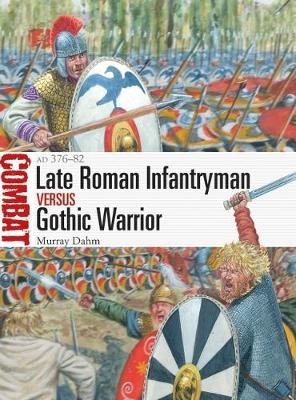
Late Roman Infantryman vs Gothic Warrior
AD 376–82
Seiten
2021
Osprey Publishing (Verlag)
978-1-4728-4528-3 (ISBN)
Osprey Publishing (Verlag)
978-1-4728-4528-3 (ISBN)
Ravaged by civil war and pressure from the Huns to the east, in late summer AD 376 the Gothic tribe of the Theruingi – up to 200,000 people under their leader Fritigern – gathered on the northern bank of the River Danube and asked the Eastern Roman emperor, Valens, for asylum within the empire. After agreeing to convert to Arian Christianity and enrol in the Roman Army, the Goths were allowed to cross the Danube and settle in the province of Thrace. Far more people crossed the Danube than the Romans expected, however, and with winter approaching, the local Roman commander, Lupicinus, lacked the resources to feed the newcomers and did not possess sufficient troops to control them. Treated poorly and running out of food, the Goths very quickly lost faith in the Roman promises.
Meanwhile, other Gothic tribes also sought permission to cross the Danube. The Greuthungi were refused permission, but soon learned that local Roman garrisons had been depleted to supervise the march of the Theruingi to the town of Marcianopolis, close to the eastern shore of the Black Sea. Taking advantage of this, the Greuthungi also entered Roman territory. Camping outside Marcianopolis, Lupicinus denied the Goths access to the town’s food stores, provoking the Theruingi to begin skirmishing with the Roman troops. Fritigern convinced Lupicinus to let the Gothic leaders go and calm their people, but they did nothing to quell the warlike temper of his warriors. Lupicinus summoned troops to him, but in late 376 these Roman forces were defeated – the first of several defeats for the Romans that would culminate in the fateful battle of Adrianople in August 378, at which Roman forces led by the emperor himself confronted the Gothic host. The aftermath and repercussions of Adrianople have been much debated, but historians agree that it marks a decisive moment in the history of the Roman world. This fully illustrated book investigates the fighting men of both sides who clashed at the battles of Marcianopolis, Ad Salices and Adrianople, as the fate of the Western Roman Empire hung in the balance.
Meanwhile, other Gothic tribes also sought permission to cross the Danube. The Greuthungi were refused permission, but soon learned that local Roman garrisons had been depleted to supervise the march of the Theruingi to the town of Marcianopolis, close to the eastern shore of the Black Sea. Taking advantage of this, the Greuthungi also entered Roman territory. Camping outside Marcianopolis, Lupicinus denied the Goths access to the town’s food stores, provoking the Theruingi to begin skirmishing with the Roman troops. Fritigern convinced Lupicinus to let the Gothic leaders go and calm their people, but they did nothing to quell the warlike temper of his warriors. Lupicinus summoned troops to him, but in late 376 these Roman forces were defeated – the first of several defeats for the Romans that would culminate in the fateful battle of Adrianople in August 378, at which Roman forces led by the emperor himself confronted the Gothic host. The aftermath and repercussions of Adrianople have been much debated, but historians agree that it marks a decisive moment in the history of the Roman world. This fully illustrated book investigates the fighting men of both sides who clashed at the battles of Marcianopolis, Ad Salices and Adrianople, as the fate of the Western Roman Empire hung in the balance.
Murray Dahm is a freelance historian and the author of Greek Hoplite vs Persian Warrior for Osprey. He has written more than 50 articles for magazines such as Ancient Warfare, Medieval Warfare and Ancient History. Murray lives in Australia. Giuseppe Rava was born in Faenza in 1963, and took an interest in all things military from an early age. Entirely self-taught, Giuseppe has established himself as a leading military history artist and is inspired by the works of the great military artists, such as Detaille, Meissonier, Röchling, Lady Butler, Ottenfeld and Angus McBride. He lives and works in Italy.
Introduction
The Opposing Sides
Marcianopolis, AD 376
The Willows, AD 377
Adrianople, 9 August AD 378
Analysis
Aftermath
Bibliography
Index
| Erscheinungsdatum | 21.06.2021 |
|---|---|
| Reihe/Serie | Combat |
| Illustrationen | Giuseppe Rava |
| Sprache | englisch |
| Maße | 184 x 248 mm |
| Gewicht | 264 g |
| Themenwelt | Geschichte ► Allgemeine Geschichte ► Vor- und Frühgeschichte |
| Geschichte ► Allgemeine Geschichte ► Altertum / Antike | |
| Geschichte ► Teilgebiete der Geschichte ► Militärgeschichte | |
| Sozialwissenschaften ► Politik / Verwaltung | |
| ISBN-10 | 1-4728-4528-5 / 1472845285 |
| ISBN-13 | 978-1-4728-4528-3 / 9781472845283 |
| Zustand | Neuware |
| Haben Sie eine Frage zum Produkt? |
Mehr entdecken
aus dem Bereich
aus dem Bereich
auf den Spuren der frühen Zivilisationen
Buch | Hardcover (2023)
C.H.Beck (Verlag)
20,00 €
Was Pompeji über uns erzählt
Buch | Hardcover (2023)
Propyläen (Verlag)
32,00 €


